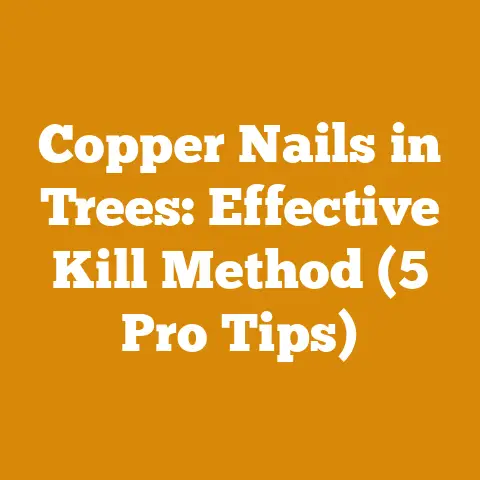How to Adjust Pressure on Pressure Washer Pump (Triplex Pump Tips)
Understanding and Adjusting Pressure on Your Pressure Washer Pump: A Triplex Pump Guide
As someone who’s spent countless hours processing wood, from felling trees in the biting winter wind to meticulously splitting firewood for the hearth, I know the value of having the right tool for the job. Just like a well-maintained chainsaw is crucial for efficient logging, a properly functioning pressure washer is invaluable for cleaning equipment, preparing surfaces for staining, or even removing stubborn bark from logs. And at the heart of many powerful pressure washers lies the triplex pump.
This guide dives deep into the world of triplex pressure washer pumps, focusing specifically on understanding and adjusting their pressure. Whether you’re a seasoned woodworker, a weekend warrior tackling home projects, or a small-scale logging operation owner, understanding how to fine-tune your pressure washer will not only improve its performance but also extend its lifespan.
Blending Styles: Why Understanding Pressure is Crucial
Before we dive into the nitty-gritty of triplex pumps, let’s talk blending. Just as a fine whiskey blends different flavors to create a harmonious whole, adjusting the pressure on your pressure washer is about blending the right amount of force with the right application. Too much pressure, and you risk damaging delicate surfaces, stripping paint, or even etching wood. Too little, and you’re wasting time and effort.
Imagine trying to remove old, flaky paint from a delicate piece of antique furniture. You wouldn’t just blast it with the highest pressure setting, would you? You’d carefully adjust the pressure to a level that gently removes the paint without harming the wood underneath. It’s the same principle whether you’re cleaning a deck, washing a car, or even prepping logs for milling.
What is a Triplex Pump and Why Does It Matter?
The triplex pump is a common type of positive displacement pump used in pressure washers. Unlike simpler axial cam pumps, triplex pumps use three pistons that reciprocate within cylinders to deliver high-pressure water. This design offers several advantages:
- Higher Pressure: Triplex pumps can generate significantly higher pressure than axial cam pumps, making them suitable for demanding cleaning tasks. Typical pressures range from 2000 PSI (pounds per square inch) to over 4000 PSI.
- Longer Lifespan: The robust construction and lower operating speeds of triplex pumps generally translate to a longer lifespan compared to axial cam pumps. This is crucial when you are dealing with demanding and time-sensitive projects.
- Greater Efficiency: Triplex pumps are more efficient at converting engine power into water pressure.
- Smoother Operation: Three pistons ensure a smoother, more consistent flow of water, reducing pulsations and vibrations.
Understanding the Pressure Adjustment Mechanism
The pressure adjustment mechanism on a triplex pump typically involves a bypass valve or unloader valve. This valve regulates the amount of water that is bypassed back to the pump inlet, effectively controlling the pressure at the outlet.
Types of Unloader Valves:
- Pressure-Actuated Unloader Valve: This type of valve opens when the pressure at the pump outlet reaches a preset level. When the trigger on the spray gun is released, the valve opens, allowing water to bypass the pump and reducing the pressure in the system.
- Flow-Actuated Unloader Valve: This type of valve opens when the flow of water through the pump decreases, such as when the trigger on the spray gun is released.
- Adjustable Unloader Valve: This type of valve allows you to manually adjust the pressure at which the valve opens, giving you greater control over the pressure output of the pressure washer.
How the Unloader Valve Works:
Think of the unloader valve as a pressure relief valve. When the pressure in the system exceeds the valve’s set point, the valve opens, diverting water back to the pump inlet. This reduces the pressure at the outlet and prevents the pump from over-pressurizing.
Technical Detail: The unloader valve typically consists of a spring-loaded poppet or ball valve. The spring tension determines the pressure at which the valve opens. By adjusting the spring tension, you can adjust the pressure output of the pump.
Identifying the Pressure Adjustment Point
The first step in adjusting the pressure is to locate the pressure adjustment point on your pressure washer. This is usually a knob or screw located on or near the unloader valve. Refer to your pressure washer’s owner’s manual for the exact location.
Common Locations:
- On the unloader valve itself.
- On the pump housing near the unloader valve.
- On the control panel of the pressure washer.
Visual Clues:
- Look for a knob or screw with markings indicating pressure settings (e.g., “Min,” “Max,” or a pressure scale).
- The adjustment point may be labeled with the word “Pressure” or “Unloader.”
Safety Note: Before attempting to adjust the pressure, ensure that the pressure washer is turned off and disconnected from the power source.
Step-by-Step Guide to Adjusting Pressure
Here’s a step-by-step guide on how to adjust the pressure on your triplex pressure washer pump:
- Safety First: Disconnect the pressure washer from the power source and turn off the water supply. Release any pressure in the system by squeezing the trigger on the spray gun.
- Locate the Adjustment Point: Refer to your owner’s manual to identify the pressure adjustment knob or screw.
- Start Low: Begin by setting the pressure to its lowest setting. This will help prevent damage to the surface you’re cleaning.
- Connect Water Supply: Connect the water supply to the pressure washer.
- Start the Pressure Washer: Turn on the pressure washer and let it run for a few seconds to prime the pump.
- Test the Pressure: Squeeze the trigger on the spray gun and observe the pressure. You can use a pressure gauge to get an accurate reading.
- Adjust the Pressure: Turn the pressure adjustment knob or screw to increase or decrease the pressure as needed. Make small adjustments and test the pressure after each adjustment.
- Repeat Steps 6 and 7: Continue adjusting the pressure until you reach the desired level.
- Fine-Tune: Once you’ve reached the desired pressure, fine-tune the adjustment to achieve the optimal cleaning performance for your specific task.
Practical Tip: Always start with a lower pressure setting and gradually increase it until you achieve the desired cleaning power. This will help prevent damage to the surface you’re cleaning.
Troubleshooting Common Pressure Problems
Sometimes, despite your best efforts, you might encounter problems with your pressure washer’s pressure. Here are some common issues and how to troubleshoot them:
1. Low Pressure:
- Clogged Nozzle: A clogged nozzle can restrict water flow and reduce pressure. Clean the nozzle with a nozzle cleaning tool or a small wire.
- Clogged Water Inlet Filter: A clogged water inlet filter can restrict water flow to the pump. Clean the filter with water and a soft brush.
- Air in the Pump: Air in the pump can reduce pressure. Purge the air from the pump by running the pressure washer with the spray gun trigger squeezed until a steady stream of water flows.
- Worn Pump Seals: Worn pump seals can leak water and reduce pressure. Replace the seals if they are worn or damaged.
- Unloader Valve Issues: A malfunctioning unloader valve can cause low pressure. Inspect the unloader valve for damage or debris. Clean or replace the valve as needed.
2. High Pressure:
- Incorrect Nozzle: Using a nozzle with a small orifice can increase pressure. Use a nozzle with a larger orifice to reduce pressure.
- Unloader Valve Issues: A malfunctioning unloader valve can cause high pressure. Inspect the unloader valve for damage or debris. Clean or replace the valve as needed.
- Pressure Adjustment Set Too High: Ensure that the pressure adjustment knob or screw is not set too high.
3. Pulsating Pressure:
- Air in the Pump: Air in the pump can cause pulsating pressure. Purge the air from the pump by running the pressure washer with the spray gun trigger squeezed until a steady stream of water flows.
- Worn Pump Seals: Worn pump seals can cause pulsating pressure. Replace the seals if they are worn or damaged.
- Clogged Nozzle: A clogged nozzle can cause pulsating pressure. Clean the nozzle with a nozzle cleaning tool or a small wire.
4. No Pressure:
- No Water Supply: Ensure that the water supply is turned on and that there is sufficient water pressure.
- Clogged Water Inlet Filter: A clogged water inlet filter can prevent water from reaching the pump. Clean the filter with water and a soft brush.
- Pump Failure: If the pump is not working, it may need to be repaired or replaced.
Technical Tip: When troubleshooting pressure problems, start with the simplest solutions first, such as cleaning the nozzle or checking the water supply.
Maintaining Your Triplex Pump for Optimal Performance
Proper maintenance is crucial for extending the life of your triplex pump and ensuring optimal performance. Here are some essential maintenance tips:
- Use Clean Water: Always use clean, filtered water to prevent debris from clogging the pump and damaging the seals.
- Prevent Freezing: Protect the pump from freezing temperatures, as ice can damage the internal components. Store the pressure washer in a heated area or use antifreeze in the pump during cold weather.
- Use Pump Protector: Use a pump protector to lubricate the seals and prevent corrosion when storing the pressure washer for extended periods.
- Change the Oil Regularly: Change the oil in the pump according to the manufacturer’s recommendations. This will help keep the pump lubricated and prevent wear.
- Inspect Hoses and Connections: Regularly inspect the hoses and connections for leaks or damage. Replace any damaged parts immediately.
- Store Properly: Store the pressure washer in a clean, dry place.
Data Point: Regular oil changes can extend the lifespan of a triplex pump by up to 50%.
Choosing the Right Nozzle for the Job
The nozzle you use on your pressure washer plays a significant role in determining the pressure and cleaning power. Different nozzles produce different spray patterns and pressures.
Common Nozzle Types:
- 0-Degree Nozzle (Red): This nozzle produces a highly concentrated, high-pressure stream of water. It is ideal for removing stubborn dirt and grime from small areas. Caution: Use this nozzle with extreme care, as it can damage delicate surfaces.
- 15-Degree Nozzle (Yellow): This nozzle produces a narrow, high-pressure fan spray. It is suitable for cleaning concrete, brick, and other tough surfaces.
- 25-Degree Nozzle (Green): This nozzle produces a wider, medium-pressure fan spray. It is ideal for general cleaning tasks, such as washing cars, decks, and siding.
- 40-Degree Nozzle (White): This nozzle produces a wide, low-pressure fan spray. It is suitable for delicate surfaces, such as painted wood and stucco.
- Soap Nozzle (Black): This nozzle produces a low-pressure spray for applying soap or detergent.
Nozzle Selection Guide:
| Surface | Recommended Nozzle | Pressure Setting |
|---|---|---|
| Concrete | 15-Degree | Medium-High |
| Brick | 15-Degree | Medium |
| Wood (Deck) | 25-Degree | Low-Medium |
| Wood (Siding) | 40-Degree | Low |
| Car | 40-Degree or Soap | Low |
Practical Tip: Always test the nozzle on an inconspicuous area before cleaning the entire surface.
Safety Considerations When Using a Pressure Washer
Pressure washers can be powerful tools, but they can also be dangerous if used improperly. Here are some important safety considerations:
- Wear Safety Glasses: Always wear safety glasses to protect your eyes from flying debris.
- Wear Hearing Protection: Pressure washers can be noisy, so wear hearing protection to prevent hearing damage.
- Wear Closed-Toe Shoes: Wear closed-toe shoes to protect your feet from injury.
- Never Point the Nozzle at People or Animals: The high-pressure stream of water can cause serious injury.
- Keep Children and Pets Away: Keep children and pets away from the work area.
- Use the Proper Nozzle: Use the correct nozzle for the job to avoid damaging the surface you’re cleaning.
- Maintain a Safe Distance: Maintain a safe distance from the surface you’re cleaning.
- Never Use a Pressure Washer Indoors: Pressure washers produce carbon monoxide, which is a deadly gas.
- Read the Owner’s Manual: Always read and follow the manufacturer’s instructions.
Safety Code: Always wear appropriate personal protective equipment (PPE) when operating a pressure washer. This includes safety glasses, hearing protection, and closed-toe shoes.
Case Study: Reviving a Weather-Beaten Deck
I once had a client who had a beautiful cedar deck that had been neglected for years. The wood was covered in algae, dirt, and mildew, and it looked like it was beyond repair. They were ready to tear it down and replace it. I convinced them to let me try to revive it with my pressure washer.
I started by using a 40-degree nozzle and a low-pressure setting to gently remove the loose debris. Then, I switched to a 25-degree nozzle and a slightly higher pressure setting to clean the remaining algae and mildew. I was careful not to hold the nozzle too close to the wood, as this could damage the surface.
After cleaning the deck, I applied a wood brightener to restore the color and remove any remaining stains. Finally, I applied a sealant to protect the wood from future damage.
The result was amazing. The deck looked almost brand new. The client was thrilled, and they saved thousands of dollars by not having to replace it.
Technical Detail: I used a wood brightener containing oxalic acid to remove the stains. Oxalic acid is a mild acid that is effective at removing stains from wood without damaging the surface.
Beyond the Basics: Advanced Pressure Washing Techniques
Once you’ve mastered the basics of pressure washing, you can explore some advanced techniques to improve your results.
- Using Detergents: Adding detergent to your pressure washer can help to remove stubborn dirt and grime. Use a detergent specifically designed for pressure washers.
- Sandblasting: You can use a pressure washer with a sandblasting attachment to remove paint, rust, and other coatings from metal surfaces.
- Surface Cleaners: Surface cleaners are attachments that provide a wider cleaning path and more consistent cleaning results. They are ideal for cleaning large areas, such as driveways and patios.
- Extension Wands: Extension wands allow you to reach high areas without using a ladder.
Practical Tip: When using detergents or sandblasting attachments, always follow the manufacturer’s instructions carefully.
The Future of Pressure Washing Technology
Pressure washing technology is constantly evolving. Here are some trends to watch for:
- Electric Pressure Washers: Electric pressure washers are becoming more powerful and efficient. They are also quieter and more environmentally friendly than gas-powered pressure washers.
- Smart Pressure Washers: Some pressure washers now come with smart features, such as Bluetooth connectivity and smartphone apps. These features allow you to monitor the pressure, adjust the settings, and track your cleaning progress.
- Eco-Friendly Pressure Washers: Manufacturers are developing more eco-friendly pressure washers that use less water and energy.
Unique Insight: As environmental concerns grow, expect to see more pressure washers designed to minimize water consumption and reduce reliance on harsh chemicals.
Making the Right Choice for Your Needs: A Summary
Adjusting the pressure on your triplex pressure washer pump is a crucial skill for achieving optimal cleaning performance and preventing damage to the surfaces you’re cleaning. By understanding the pressure adjustment mechanism, troubleshooting common problems, and maintaining your pump properly, you can ensure that your pressure washer remains a valuable tool for years to come.
Remember to always prioritize safety and follow the manufacturer’s instructions. With a little practice and attention to detail, you’ll be able to master the art of pressure washing and tackle any cleaning task with confidence. Just like choosing the right chainsaw for the job, selecting the right pressure and nozzle for the task at hand will help you achieve the best possible result. And that, my friends, is what it’s all about.






